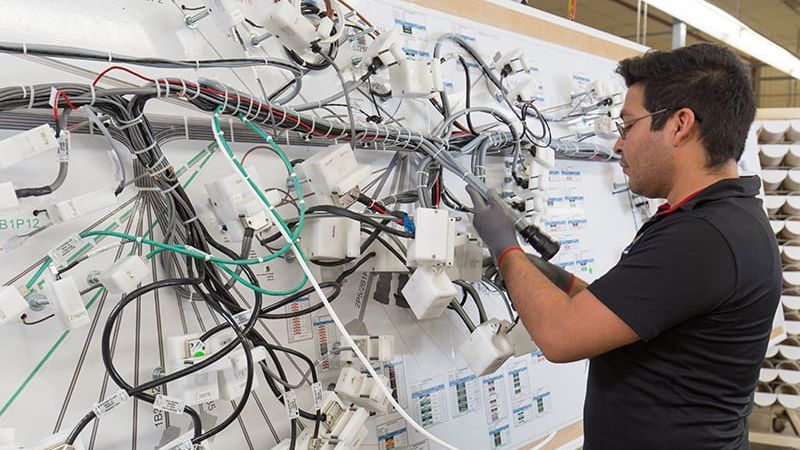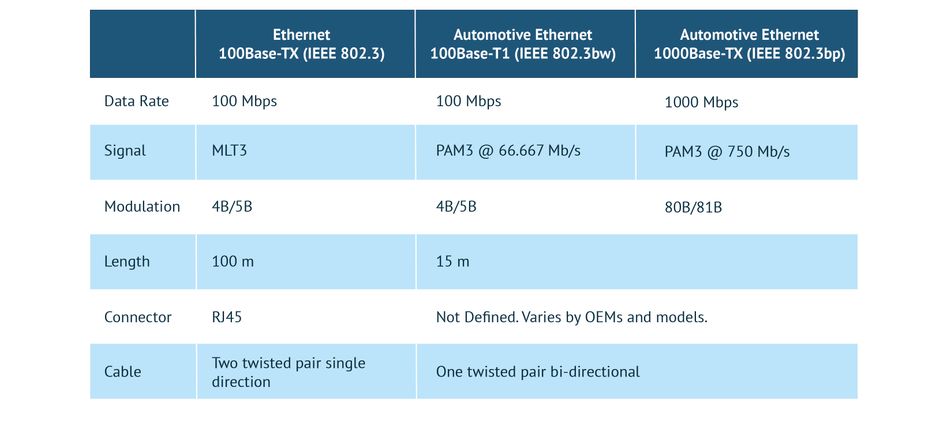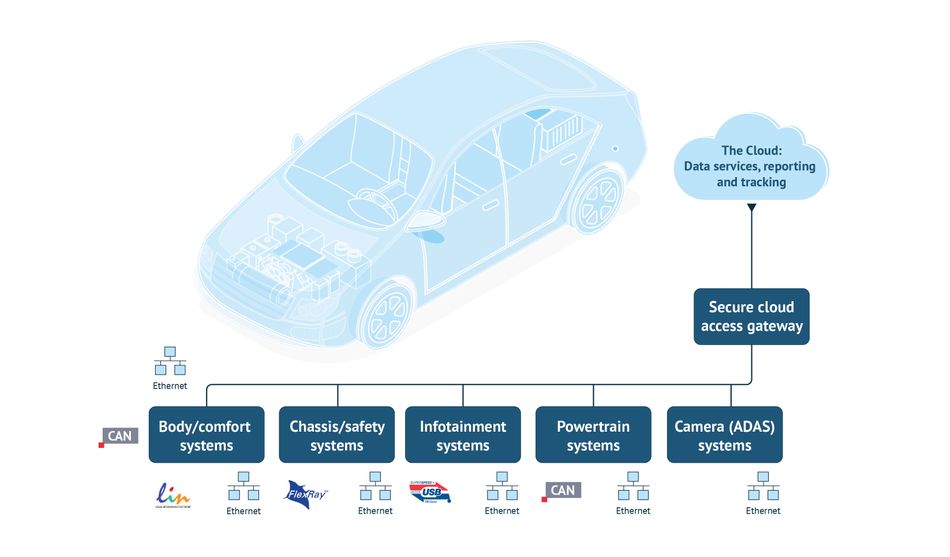Automotive Ethernet Provides an Optimum Data Network
Today’s automobiles are data centers on wheels. This article explores the various single-pair Ethernet standards and explains how they work together to create an optimum automobile communication network for everything from camera, video, and GPS to more critical safety systems.

This is the third article in a 5-part series exploring the future of mobility. The series looks into which technologies enable rapid advancements in the efficiency, safety, and power of the vehicles of tomorrow. The series looks into which technologies are enabling the necessary rapid advancements in efficiency, safety, and power. This series is sponsored by Mouser Electronics, an online distributor of electronic components. Through their sponsorship, Mouser Electronics is dedicated to supporting a future of connected and efficient mobility.
Introduction
Today’s automobiles are data centers on wheels. Features such as collision detection, lane departure warnings, and autonomous driving are a reality and will be globally implemented in the next decade. But these safety features need vast amounts of secure data processing, networking, and storage capabilities within the vehicle. A good example is the higher data throughput necessary for advanced driver-assistance systems (ADAS) such as those found in rearview or surround-view camera systems.
Ethernet/In-Vehicle Network (IVN) could bring the capability necessary. Ethernet connectivity is provided at high-speed communications over a ubiquitous physical network in the vehicle.
How is this achieved?
This article explores the various single-pair Ethernet standards and explains how they work together to create an optimum automobile communication network for everything from camera, video, and GPS to more critical safety systems.
Single-Pair Ethernet (SPE)
Traditional Ethernet cabling, which has been the standard for most Ethernet cables worldwide, uses two pairs of wires to transmit data (1). On the other hand, single-pair wire Ethernet, a network technology, with bi-directional, twisted, and unshielded wiring for automotive Ethernet is the enabler of parallel, high-performance transmission of data. Supporting also the so-called power through Power over Data Line (PoDL) from sensors on to the cloud.
It is expected that this technology will enable lighter and lower-cost cables to take up less volume in the vehicle while reducing the chances of electromagnetic discharges. Lighter cables also mean improved gas mileage. For those engineers concerned about installation, the use of single pair wire should be simpler.
Single-Pair Ethernet technologies are standards-based technologies. The first two IEEE standards for this are 802.3bw and 802.3bp. They are identified as 100BASESE-TX. These two standards are 100BASE-T1 and 1000BASE-TI technologies capable of 100Mbps/15m and 1Gbps/40m speed and distance limits, respectively. These standards-based technologies will easily meet future automotive needs.
These two standards are driving pioneering applications such as in-car innovations like in-vehicle communications, measurement and arbitration, diagnostics via Diagnostic Communication over Internet Protocol (DoIP), and communications between electric vehicles and charging stations. Ethernet provides the vehicle with a flexible, modular structure that is also well tailored for specific security solutions in the vehicle. Ethernet is secure over the internet as well.
Standard Ethernet vs. Automotive Ethernet
Ethernet technology is used for in-vehicle communication, measurement and calibration, and diagnostics via DoIP. This is the packaging of diagnostic messages in Ethernet frames to communicate a diagnostic tester with a vehicle. Vehicle access with DoIP is backward compatible using discretionary pins of the existing diagnostic connector. DoIP enables easy integration into various network structures, even with WLAN.

Automotive Ethernet is a different, more demanding technology than traditional Ethernet (See Figure 1). All automotive-grade Ethernet products will need to be AEC-Q100-qualified and support the automotive industry’s Production Part Approval Process (PPAP).
One main difference between automotive and standard Ethernet is that EMC and temperature environments are far harsher in the automobile. A higher Mean Time Between Failures (MTBF) is also needed for higher reliability in automotive technologies. Repeatability/higher MTBF and predictability are critical in the automobile for safety because failures can cause injuries and even loss of life. Safety/ASIL (ISO26262) compliance is necessary.
Hardware qualification is required in some Automotive Ethernet applications. Lower latency is usually required in the vehicle’s drivetrain for fast reactions at highway and road vehicle speeds. Validation of Electronic Control Unit (ECU) hardware and software are also required. A typical vehicle will have more than 100 ECUs that control braking, engine, transmission (drivetrain) steering, cameras, wireless communication, and more.
Present-Day In-Vehicle Technology
Various communication systems currently exist within a typical automobile, including CAN, LIN, and FlexRay, to name a few (see Figure 2). These systems are predicted to remain in the automobile for a while longer while IVN technologies powered by Ethernet slowly become the common denominator. The future of automotive networking is Ethernet, especially single-pair Ethernet, which can transport data over a link 100x faster than the present CAN bus.

The 100BASE-T1 standard was first introduced in series production cars in 2013, and the technology was standardized in 2015 for single balanced twisted-pair cable in IEEE 802.3bw;
IEEE Standard for Ethernet Amendment 1: Physical Layer Specifications and Management Parameters for 100Mb/s Operation over a Single Balanced Twisted Pair Cable (100BASE-T1).
An example of a 100BASE-T1 Ethernet PHY Transceiver is LAN8770. (see the Ethernet Evaluation board EVB-LAN8770-RMII, a plug-in card that interfaces directly with a mating Microchip host processor or controller board.)
The next-gen 1Gb/s technologies are also in automobiles today; 1000BASE-T1 defined in 2016 in;
IEEE Standard for Ethernet Amendment 4: IEEE 802.3bp™, Physical Layer Specifications and Management Parameters for 1Gb/s Operation over a Single Twisted-Pair Copper Cable), and
The 1000BASE-RH defined in 2017 in IEEE 802.3bv™ is also of significant importance;
IEEE Standard for Ethernet Amendment 9: Physical Layer Specifications and Management Parameters for 1000Mb/s Operation Over Plastic Optical Fiber.
Two other new IEEE standardized spec speeds are at 10Mb/s in IEEE 802.3cg™ and 2.5/5/10 gigabits per second in IEEE 802.3ch™ and were published in 2019 and 2020, respectively. Work is underway to standardize greater than 10Gb/s (IEEE P802.3cy™ and IEEE P802.3cz™).
After 2021, all major Original Equipment Manufacturers (OEMs) should have introduced the 100BASE-T1 specification for transmitting at 100Mb/s data rate over unshielded cables in production automobiles. With the rapid evolution of vehicle networking systems, the 100BASETX family is foreseen to replace most other in-vehicle communication systems and help lower vehicle cost.
Competing Communication Technologies
The 100Mb/s and 1000Mb/s Ethernet address clear-cut speed gaps for IVN technology. New speed grades in Automotive Ethernet encounter more competition in both lower (FlexRay, various CAN variants, and A2B audio bus) and higher-speed areas (SerDes, USB, and PCIe). Usually, specialized technologies have an advantage in the beginning since they are tailored for specific use cases and cost-optimized for those areas. For example, the 2.5/5/10G Base-T1 will be implemented in 2025 for ADAS and autonomous vehicles (see the 2020 Autonomous Vehicle Technology Report) with an average of more than 100 Ethernet ports per vehicle.
Technologies developed for a single-use case can quickly become monolithic and high cost when applied to other uses. Globally standardized technologies like Ethernet grow to be augmented by a qualification ecosystem such as test houses, vendors, intelligent tools, training, and a diversified product portfolio that is critical to OEMs in areas such as risk mitigation. Despite this challenge, global applications of Ethernet are becoming more visible, and physical layer network technologies such as single-pair Ethernet are allowing to cover major ranges in industrial areas beyond the automotive.
Conclusion
The automotive industry around the globe is constantly transforming the path forward for the standardized in-vehicle network (IVN) foundation and IEEE 802.3 Ethernet or P802.1DG are helping to build the road for fast and secure Ethernet systems. Single-pair Ethernet is now a regular standard solution used by all major OEMs in series production cars from 2021 on. Global automotive decision-makers need to keep up and march at the same speed of technological transformation to bring the industry together and answer the difficult questions about network communications within the vehicle by ensuring reliability, performance and overall safety. Ethernet will most likely be the winner because it can offer the best solution on all software and protocol stack layers.
This article was initially published by Mouser and Microchip in an e-magazine. It has been substantially edited by the Wevolver team and engineer Nicolas Sarmiento Sierra. It's the third article of a 5-part series exploring the technologies that enable the future of mobility. Future articles will examine the cybersecurity concerns in connected vehicles, discuss solutions for fast charging, and dive into how ethernet can deliver optimum data networks.
The first article looked at software control.
The second article examined cybersecurity concerns in connected vehicles
About the sponsor: Mouser
Mouser Electronics is a worldwide leading authorized distributor of semiconductors and electronic components for over 1,100 manufacturer brands. They specialize in the rapid introduction of new products and technologies for design engineers and buyers. Their extensive product offering includes semiconductors, interconnects, passives, and electromechanical components.
References:
1. Helukabel. Single Pair Ethernet [Internet]. 2015. Available from: https://www.wiso-net.de/document/KONP__76628ae3018b1385b369c4f867dacc373f803eb2
2. Media WB. Single pair Ethernet in the context of IIoT [Internet]. [cited 2021 Jun 16]. Available from: https://www.controlsdrivesautomation.com/Single-pair-Ethernet
3. Keysight Technologies. From Standard Ethernet To Automotive Ethernet Automotive Ethernet Tip #1 Ethernet [Internet]. Keysight Technologies; 2019. p. 1–2. Available from: www.keysight.com
4. Onsemi. Basics of In-Vehicle Networking ( IVN ) ON Semiconductor products Major IVN technologies overview [Internet]. 2021 [cited 2021 Jun 15]. Available from: https://www.onsemi.com/